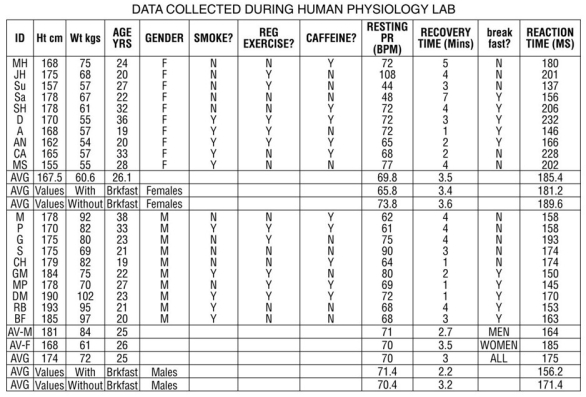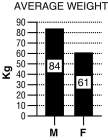Following is a table of data collected from one section of an 8 a.m.physiology lab.There were 20 students present, 10 men and 10 women.Information collected from the students included their height, weight, age, gender, and resting pulse rate.In addition, the students were surveyed to see if they smoked cigarettes, considered themselves "regular exercisers," if they had consumed caffeine the morning of the lab, and if they had eaten breakfast that day.A "y" or "n" (yes or no) was recorded to indicate their answers.Each student did "jumping jacks" for 5 minutes and recorded the time required to regain their resting heart rate, which is listed on the table as "recovery time." Finally, each student participated in an exercise designed to measure their reaction time (in milliseconds) in catching an object dropped by a lab partner according to specified criteria.Use this table to answer the following questions.Ignore statistical problems caused by small sample size, and so on.

Table 1.3

Figure 1.3
For these questions, the data were separated and analyzed by gender.
-Refer to Table 1.3 and Figure 1.3 (bar graph).
A.Write a hypothesis regarding gender and weight.
B.What is the dependent variable? What is the independent variable?
C.Based on the data in the graph above, what is your conclusion?
D.Why is a bar graph a good choice for presentation of these data? Would another type of chart be as effective?
Definitions:
Favourable Treatment
Preferential treatment or advantage given to a person or group over others.
Protectionism
Economic policy measures implemented by a government to shield domestic industries from foreign competition, often through tariffs and quotas.
Cultural Miscues
Misunderstandings or errors in communication that occur due to differences in cultural norms and expectations.
International Business
Commercial transactions and activities that occur across national borders.
Q4: A lack of iron reduces the amount
Q14: Drinking alcohol with meals slows its absorption.
Q15: Older adults should consume a diet that
Q30: To burn the most body fat possible
Q45: A horse runs 10 races, each a
Q54: The larger the number of adipocytes, the
Q59: Compare and contrast the chemical bonds between
Q66: Chromium is<br>A) not an element in the
Q104: When a chemical reaction is in equilibrium,<br>A)
Q131: To activate a regulated gene, the formation